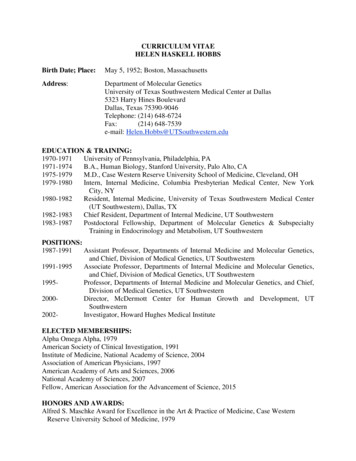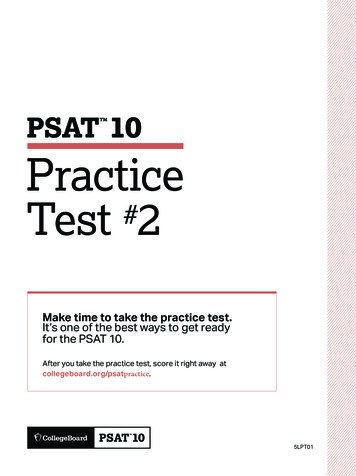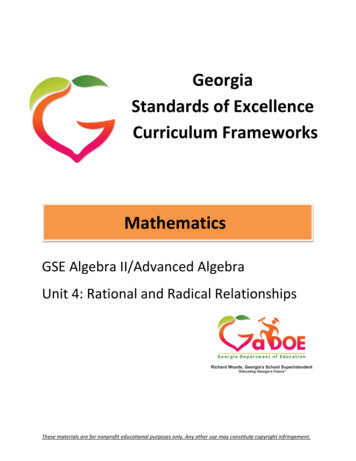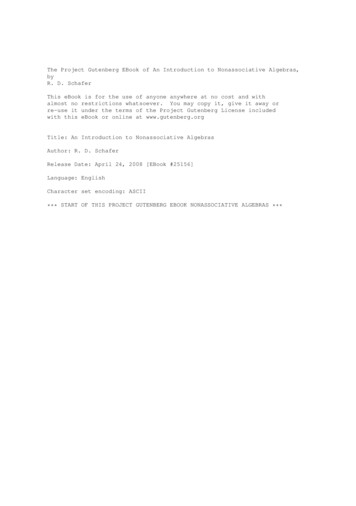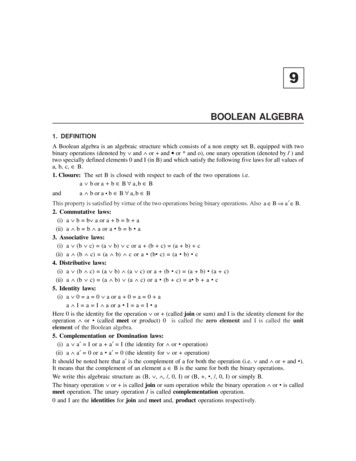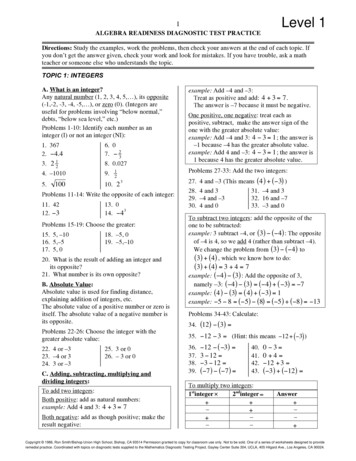
Transcription
Level 11ALGEBRA READINESS DIAGNOSTIC TEST PRACTICEDirections: Study the examples, work the problems, then check your answers at the end of each topic. Ifyou don’t get the answer given, check your work and look for mistakes. If you have trouble, ask a mathteacher or someone else who understands the topic.TOPIC 1: INTEGERSA. What is an integer?Any natural number (1, 2, 3, 4, 5, ), its opposite(-1,-2, -3, -4, -5, ), or zero (0). (Integers areuseful for problems involving “below normal,”debts, “below sea level,” etc.)Problems 1-10: Identify each number as aninteger (I) or not an integer (NI):1. 3672. !4.46. 07. " 233. 2 128. 0.0274. –10109.5.100!3!Problems 11-14: Write the opposite of each integer:!11. 4212. !3!13. 0314. !4Problems 15-19: Choose the greater:15. 5, –1016. 5,–517. 5, 018. –5, 019. –5,–1020. What is the result of adding an integer andits opposite?21. What number is its own opposite?B. Absolute Value:Absolute value is used for finding distance,explaining addition of integers, etc.The absolute value of a positive number or zero isitself. The absolute value of a negative number isits opposite.Problems 22-26: Choose the integer with thegreater absolute value:22. 4 or –323. –4 or 324. 3 or –3One positive, one negative: treat each aspositive, subtract, make the answer sign of theone with the greater absolute value:example: Add –4 and 3: 4 ! 3 1 ; the answer is–1 because –4 has the greater absolute value.example: Add 4 and –3: 4 ! 3 1 ; the answer is1 because 4 has the greater absolute value.Problems 27-33: Add the two integers:1210. 2example: Add –4 and –3:Treat as positive and add: 4 3 7 .The answer is –7 because it must be negative.25. 3 or 026. – 3 or 0C. Adding, subtracting, multiplying anddividing integers:To add two integers:Both positive: add as natural numbers:example: Add 4 and 3: 4 3 7Both negative: add as though positive; make theresult negative:27. 4 and –3 (This means (4 ) (!3) )28. 4 and 329. –4 and –330. 4 and 031. –4 and 332. 16 and –733. –3 and 0To subtract two integers: add the opposite of theone to be subtracted:example: 3 subtract –4, or (3) ! (!4) : The oppositeof –4 is 4, so we add 4 (rather than subtract –4).We change the problem from (3) ! (!4) to(3) (4) , which we know how to do:(3) (4) 3 4 7example: (!4 ) ! (3) : Add the opposite of 3,namely –3: (!4 ) ! (3) (!4) ( !3) !7example: (4 ) ! (3) ( 4) (!3) 1example: !5 ! 8 (!5) ! (8) (!5 ) (!8 ) !13Problems 34-43: Calculate:34. (12) ! (3) 35. !12 ! 3 (Hint: this means "12 ("3) )36.37.38.39.!12 ! ( !3) 3 ! 12 !3 ! 12 (!7) ! (!7) 40.41.42.!43.0 !3 0 4 !12 3 (!3) (!12) To multiply two integers:1stinteger !2ndinteger – – ––Answer –– Copyright 1986, Ron Smith/Bishop Union High School, Bishop, CA 93514 Permission granted to copy for classroom use only. Not to be sold. One of a series of worksheets designed to provideremedial practice. Coordinated with topics on diagnostic tests supplied to the Mathematics Diagnostic Testing Project, Gayley Center Suite 304, UCLA, 405 Hilgard Ave., Los Angeles, CA 90024.
2Both positive: multiply as two natural numbers.example: (3) ! (4) 3 ! 4 12Both negative: multiply as if positive; and makethe answer positive. and remember, twonegatives make a positive. When multiplyingtwo negative numbers, you always get a positiveanswer.example: (!3 )( !4) so 3 ! 4 12 ; make itpositive, and the answer is 12.One positive, one negative: When multiplying anegative number and a positive number, theanswer is always negative.example: (3)( !4 ) so 3 ! 4 12 ; make theanswer negative; answer –12.Problems 44-55: Multiply:44. 3 ! ("4) !50.("4) 0 (3) ("4) 51. 0 46.47.48.49.(3)( !4 ) 3( !4 ) !(!3)( !4) !3( !4 ) 52. (!3 ) 253. (4 ) 54. ("3) 4 55. 3 4 2!example: 6 1, so the reciprocal of 6 is(And the reciprocal of(example: ("4 ) "14! is " 1 .4161.6is 6.)!!57. 158. 1059. –160. What number is its own reciprocal? (Canyou find “more than one”?)61. Using the reciprocal definition, explain whythere is no reciprocal of zero.To divide two integers: multiply by thereciprocal of the one to be divided by:example: 20 divided by !5 20 (!5) .The reciprocal of –5 is " 15 so we multiply by" 15 : 20 (!5) 20 " (! 15 ) example:!"3"662. (!14 ) ( !2) 65.63. 2 3 66.64. 3 2 67.!"15 3"5 (careful)*00 7* Problem 61 says!10 has no value (you cannotdivide by zero). !68. From the rule!for division, why is itimpossible to divide by zero?!To “sum” it all up:Positive positive larger positiveNegative negative more negativePositive negative in between both69. Given the statement “Two negatives make apositive.” Provide an example of a situationwhere the statement would be true andanother when it would be false.70. Write “18 divided by 30” in three ways:, and using a fraction bar ––.using ,) "3 ("6) "3 (" 16 ) 63 (Note negative times negative is positive.)71. 4 ! 10 3 ! 2 ! 72. 4 ! (10 3 ! 2) 73. 4 3 ! (10 ! 2) 74. 6(8 ! 3) 75. (!6 )(8) 9 76.77.78.79.80.!2 [( !6 )(8) 9] 5 (3 ! 7) 5 ! (3 ! 7) 5!3 7 !1 2 ! 3 4 81. What is the meaning of “sum”, “product”,quotient”, and “difference”?D. Factoring:If a number is the product of two (or more)integers, then the integers are factors of the number.example: 40 4 ! 10, 2 ! 20, 1 ! 40 , and 8 ! 5 .So 1, 2, 4, 5, 8, 10, 20, 40 are all factors of 40.(So are all their negatives.)Problems 82-86: Find all positive factors of:" (# 15 ) # 20 1 # 20 #41 55"5 !1 " 41example: 20 "5 20 "5 20201!Problems 62-67: Calculate:Problems 71- 80: Calculate:) 1, so the reciprocal of –4!Problems 56-59: Find the reciprocal:!56. –5 0 3 0 13 0To subtract add the opposite.To divide, multiply by the reciprocal.Reciprocals are used for dividing. Every integerexcept zero has a reciprocal. The reciprocal is!the number that multiplies the integer to give 1.1603Positive ! positive positiveNegative ! negative positivePositive ! negative negative245.example:82. 101283. 784. 2485. 986. 1If a positive integer has exactly two positivefactors, it is a prime number. Prime numbers are!Copyright 1986, Ron Smith/Bishop Union High School, Bishop, CA 93514 Permission granted to copy for classroom use only. Not to be sold. One of a series of worksheets designed to provide!!remedial practice. Coordinated with topics on diagnostic tests supplied to the Mathematics Diagnostic Testing Project, Gayley Center Suite 304, UCLA, 405 Hilgard Ave., Los Angeles, CA 90024.
3used to find the greatest common factor (GCF)and least common multiple (LCM), which areused to reduce fractions and find commondenominators, which in turn are often needed foradding and subtracting fractions.example: The only positive factors of 7 are 1 and7, so 7 is a prime number.example: 6 is not prime, as it has 4 positivefactors: 1, 2, 3, 6.87. From the prime number definition, why is 1not a prime?88. Write the 25 prime numbers from 1 to 100.Every positive integer has one way it can befactored into primes, called its prime factorization.example: Find the prime factorization (PF) of 30:30 3! 10 3 ! 2 ! 5, so the PF of 30 is 2 3 5 .example: 72 2 2 2 3 3 2 3 32 , the PF. (ThePF can be found by making a “factor tree.”)Problems 89-91: Find the PF: !!89. 3690. 1091. 7Greatest common factor (GCF) and leastcommon multiple (LCM). If you need to reviewGCF or LCM, see the worksheet in this series:“Topic 2: Fractions”.Problems 92-95: Find the GCF and the LCM of:92. 4 and 6Answers:1. I2. NI3. NI4. I5. I6. I7. NI8. NI9. NI10. I11. –4212. 313. 014. 6415. 516. 517. 518. 019. –520. zero21. zero22. 493. 4 and 9.40.41.42.43.44.–4both –9–15–1294. 4 and 895. 3 and 5E. Word problems:96. The temperature goes from !14 to 28 C.How many degrees Celsius does it change?97. 28 ! ( !14) 98. Derek owes 43, has 95, so “is worth” ?99. If you hike in Death Valley from 282 feetbelow sea level to 1000 feet above sea level,how many feet of elevation have you gained?100. 1000 ! (!282) 101. A hike from 243 feet below sea level(FBSL) to 85 FBSL means a gain in elevationof how many feet?102. !85 ! (!243 ) 103. What number added to –14 gives –24?104. What does “an integral number” mean?105. Jim wrote a check for 318. His balance isthen 2126. What was the balance before hewrote the check?106. What number multiplied by 6 gives –18?107. If you hike downhill and lose 1700 feet ofelevation and end at 3985 feet above sea level(FASL), what was your starting elevation?108. Anne was 38 miles south of her home. Shedrove 56 miles north. How far from homewas she at that time and in what direction?109. 5 subtracted from what number gives –12?110. What number minus negative four gives .60.61.62.63.64.!!–12–12–12121200916–1212" 151110–11; also –1no number times 0 172332
65.66.67.68.69.70.!–5no value (not defined)0zero has no reciprocaltrue if ! , false if .18 30 , 30 18 , 18 30)71. –572. –7!73. –1!74.!3075. –3976. 7877. 178. 979. 980. 2!!4 , !, , "81.82.83.84.85.86.87.88.1, 2, 5, 101, 71, 2, 3, 4, 6, 8, 12, 241, 3, 911 has one factor89.90.91.92.93.94.2 2 322 572, 121, 284, 895. 1, 1596. 4297. 4298. 5299. 1282100. 1282101. 158102. 158103. –10104. an integer105. 2444106. –3107. 5685 FASL108. 18 mi. N109. –7110. 62, 3, 5, 7, 11, 13, 17, 19,23, 29, 31, 37, 41, 43, 47,53, 59, 61, 67, 71, 73, 79,83, 89, 97TOPIC 2: FRACTIONSA. Greatest Common Factor (GCF):The GCF of two integers is used to simplify(reduce, rename) a fraction to an equivalentfraction. A factor is an integer multiplier. Aprime number is a positive whole number withexactly two positive factors.Problems 5-7: Find the GCF of:5. 18 and 36example: Reduce2736!!example: Find the factors of 42.Factor into primes: 42 2 3 71 is always a factor2 is a prime factor3 is a prime factor4 is!a prime factor7 is a prime factor2 3 6 is a factor2 7 14 is a factor3 7 21is a factor2 3 7 42 is a factor! Thus 42 has 8 factors.!9 39 4 99 43 1 43 34Problems 8-13: Reduce:8.9.10.13 5226 653 63 911.12. 13.!!C. Equivalent Fractions:!example:!(!343434166424422418 !is equivalentto how many eighths? 8)! 1 43 22 43 2 32 4 68Problems 14-17: Complete:!! Problems 3-4: Find all positive factors:! 3. 184. 24To find the GCF:example: Looking at the factors of 42 and 24,we see that the common factors of both are 1,2, 3, and 6, of which the greatest it 6; so: theGCF of 42 and 24 is 6. (Notice that “commonfactor” means “shared factor.”) 27:36(Note that you must be able to find a commonfactor, in this case 9, in both the top and bottom!in order to reduce.)Problems 1-2: Find the prime factorization:2. 427. 8 and 15B. Simplifying fractions:example: the prime factorization of 18 is2 3 3, or 2 32 .1. 246. 27 and 36! 14.! 15.16.!!!4 7293is how556 50100many twentieths?17. How many halves are in 3? (Hint: think 3 D. Ratio:If the ratio of boys to girls in a class is 2 to 3, itmeans that for every 2 boys, there are 3 girls. A!31 2)
5ratio is like a fraction: think of the ratio 2 to 3 asthe fraction 23 .31. Which is larger, 57 or 43 ? (Hint: find andcompare LCD fractions)32. Which is larger, 83 or 13 ?example: If the class had 12 boys, how manygirls are there? Write the fraction ratio:number of boysof girls!numberG. Adding!and!subtracting fractions: 23 12Complete the equivalent fraction:So there are 18 girls.23 2 63 618. If the class had 21 girls and the ratio of boysto girls was 2 to 3, how many boys would be!in the class?19. If the ratio of X to Y is 4 to 3, and there are462 Y’s, how many X’s are there?20. If the ratio of games won to games played is6 to 7 and 18 games were won, how manygames were played?!If denominators are the same, combine the! !numerators:7example: 10" 101 7"1 106 5310 1218Problems 33-37: Find the sum or difference(reduce if possible):!33.34.35.!E. Least common multiple (LCM):The LCM of two or more integers is used to find !the lowest common denominator of fractions in !order to add or subtract them.38.!39.Make the LCM by taking each prime factor to itsgreatest power:!LCM 2 2 33 4 27 108!24. 8 and 1225. 8, 12, and 15!!To find LCD fractions for two or more givenfractions:8example: Given 56 and 15First find LCM of 6 and 15:6 2 315 3 5 2 3 !5 30 LCDLCM !5258 16So 6 30 and 1530!27.28.2 !and33and84and540." 58 12" 23 63 " 46 3"46 "16355852" 23 41. 2 43 5 78 41 42. 3 41 "( 45 !) 12 43. 4 13 " ( 3 12 " 3) 34H. Multiplying and dividing fractions:! multiply the tops,To multiply fractions,multiply the bottoms,! and reduce if possible:3 23 26example: 4 5 4 5 20 1032929.7122330.!!!!!!!!!44.!45.46.!!!!Problems 26-32: Find equivalent fractions withthe LCD:! 26.37. 1"Problems 44-52: Calculate:F. Lowest common denominator (LCD):!! 16 1 22 3! are different, first findIf the denominatorsequivalent fractions! with common denominators(preferably the LCD):22 10 15 1 157example: 45 23 121515!327 336 2 2 3221. 6 and 1522. 4 and 823. 3 and 536. 3 Problems 38-43: Calculate:First factor into primes:Problems 21-25: Find the LCM: 27 example:To find the LCM:example: Find the LCM of 27 and 36.!4756781 2, , and 432 37and 588!!2 3 3 81 2 2 34"5 53 2 423 2(2 12 )2 50. 30 51. 8 43 49.45()()" 14 52. 15!2125!48.!making a compound fractionDivide fractions by47.and then multiply !the top and bottom (of the largerfraction) by the lowest common denominator(LCD) of both.example: 43 23 3423The LCD is 12, so multiply by 12:!!!3 1242 123 98
6example:68. Three fourths is equal to how many twelfths?69. What is 43 of a dozen?70. Joe and Mae are decorating the gym for a dance.Joe has done 13 of the work and Mae has done 25 .What fraction of the work still must be done?! The ratio of winning tickets to tickets sold is 271.to 5. If 3,500,000 are sold, how many tickets are!!winners?372. An 11 8 -inch wide board can be cut into how77 6 2 11" 2 ( 3 " 2) 6424242 2 421 6" 64"313223!Problems 53-62: Calculate:!53.32 41 54. 11 83 !55.56.!!57.!3 2434 231 121" 433458. 59.!!! !234234 60.45 5 61.38 3 !74. If Lee works 2 43 hours, what will he be paid?75. Together, what is the total time they work?76. What is their total pay?I. Comparing fractions:!!7 5, ,9 7and!34Visual Problems:!Problems 77-80: What fraction of the figure is shaded?LCD is 2 2 32 7 252795734! ! So the order7 28 1969 282525 36180 7 36252 !3 63 1894 63252is 57 , 43 , 79Problems 73-76: Inga and Lee each work for!! 4.60 per hour:73. If Inga works 3 12 hours, what will her pay be?2 13 " 1362. 3 23 1 12example: Arrange small to large:many strips of width 58 inch, if each cut takes 18inch of the width? (Must the answer be a wholenumber?)77.79.78.80.!! Fractions can also be compared by writing in!decimal from and comparing the decimals.Problems 63-65: Arrange small to large:!63.64.15 11, 687 5 11, ,8 6 1265.Problems 81-83: What letter best locates the givennumber?P QRST2, 7 , 5 , 253 12 6 360Word Problems:66. How many 2’s!are in 8?67. How many 12 ’s are in 8?!!Answers:1. 2 3 32.! 2 3 73. 1, 2, 3, 6. 9, 184. 1, 2, 3, 4, 6, 8, 12, 24!5. 18!6. 97. 18. 149.10.!11.25341481.59172782.3747573467183.23! ! ! ! ! 1621308!!23.24.25.26.15!241206, 29927.9, 14242412 10,15 156, 8, 912 12 127, 2028924 21)288)24
750.51.52.53.54.246!55.3898!!56.57. 658. 83!59.6733.34. 135. 14!36. 3 1237.13!38. " 151!39.!40.!!41. 8 5842. 343. 3 56!44.!!45.46. 447. 169!48.!7815460.141361.!62.!63.!!9449. 6 14 or!!25464.25615 161642518123111,65,67,1265.66. 4!!!1587,82,31,400,00018; yes 16.10 12.656 14 28.7578.2325113579.80. 12581. Q82. T83. SB. Fraction-decimal conversion:Each digit position has a value ten times theplace to its right. The part to the left of the pointis the whole number part.Fraction to decimal: divide the top by the bottom:example: 43 3 4 0.75203example: 3 25example:example: 324.519 ( 3 "100) (2 "10) (4 "1)!Problems 11-14: Write each as a decimal. If thedecimal repeats, show the repeating block:Problems 1-5: Which is larger?!4. 1.9 or 1.095. .5 or .49Problems 6-8: Arrange in order of size fromsmallest to largest:8. 4.5, 5.4, 4.49, 5.41Repeating decimals are shown with a bar overthe repeating block of digits:example: .3 means .333333333 example: .43 means .4343434343 example: .43 means .4333333333 Problems 9-10: Arrange in order, large to small: 20 3 6.6 3 25 3 (2 5) 3 .4 3.4!11 (5 " 101 ) (1" 100) (9 " 1000)9. .3 , .3, .3410. .6, .67 , .67, .67 , .6415!!A. Meaning!of Places:6. .02, .2, .19, .00857. .45, .449, .451, .5!!1699!!!TOPIC 3: DECIMALS1. .59 or .7!2. .02 or .033. .2 or .03!111225, 563667.68.69.70.71.72.73.74.75.76.77.11.12.!!5837 13. 4 13 14.3100 Non-repeating decimals to fractions: say thenumber as a fraction,! write the fraction you say;reduce if possible:!4 25example: .4 four tenths 10example: 3.76 three and seventy six76 3 19hundredths 3 10025Problems 15-18:! Write as a fraction:15. .01 16.! .38 17. 4.9 18. 1.25 Comparison of fractions and decimals: usually it iseasiest to convert fractions to decimals, thencompare:example: Arrange from small to large: .3, 25 , .3 , 27!!
8As decimals these are: .3, .4, .33333 , .285714 So the order is: .285714 , .3. .3 , .4, or 27 , .3, .3, 25Problems 19-21: Arrange in order, small to large:!1519. !23 , .6, .67, .6721. 100, .01, .009, 500, 0.88 !20. 78 , 0.87, 1316!!Adding and subtracting decimals: like placesmust be combined!(line up the points):example: 4 .3 4.3example: 3.43 .791 12 :example: 8 ! 4.96 :8. 00"4.96!3.04!3.430.79112.00016.221example: 6.04 ! ( 2 ! 1.4 ) 6.04 ! .6 5.44Problems 22-30: Calculate:22.23.24.25.26.27.28.29.30.!5.4 .78 1.36 ! 0.63 4 ! .3 .001 ! .01 .1 3.54 ! 1.68 17 ! 10.50 17.5 ! 10 4 .3 .02 .001 8.3 ! 0.92 4.7 47 0.47 C. Multiplying and dividing decimals:Multiplying decimalsexample: .3 ! .5 .15example: .3 ! .2 .062example: (.03) .000931. 3.24 ! 10 32. .01! .2 34. 5 ! 0.4 235. (.51) 233. (.04) Dividing decimals: Change the problem to anequivalent whole number problem by multiplyingboth numbers by the same power of 10:example: .3 .03Multiply both by 100 to get 30 3 10example: .014.07Multiply both by 1000 to get 14 70 .2 40. 7.202.441. 1.44 2.4 42. 36.81036. .013 100 !37. .053 .2 38. 3403.439.!!8.40.07 !!D. Percent:Meaning: translate percent as hundredths:example: 8% means 8 hundredths or .08 or8100 225Percent-decimal conversion: To change a decimalto percent form, multiply by 100 (move the point 2places right), write the percent symbol (%):example: .075 7.5%example: 1 41 1.25 125%Problems 43-45: Write as a percent:43. .3 44. 4 45. .085 !To change a percent to decimal form, move thepoint 2 places left (divide by 100) and drop the% symbol:example: 8.76% .0876example: 67% .67Problems 46-49: Write as a decimal:46. 10% 47. 136% 48. .03% 49. 4% Solving percent problems:Step 1: Without changing the meaning, write theproblems so it says “ of is ”, and fromthis, identify a, b, and c:a % of b is cProblems 50-52: Write in the form a% of b is c,and tell the values of a, b, and c:50. 3% of 40 is 1.251. 600 is 150% of 40052. 3 out of 12 is 25%Step 2: Given a and b, change a% to a decimaland multiply (“of” can be translated “multiply”).Or, given c and one of the others, divide c by theother (first change percent to decimal); if answeris a, write it as a percent:example: What is 9.4% of 5000?Compare a% of b is c: 9.4% of 5000 is ?Given a and b: multiply:.094 ! 5000 470example: 56 problems correct out of 80 is whatpercent?Compare a% of b is c: % of 80 is 56?Given c and other (b):56 80 .7 70%example: 5610 people, which is 60% of theregistered voters, vote in an election. Howmany are registered?Compare a% of b is c: 60% of is 5610?Given c and other (a): 5610 .6 9350
953.54.55.56.57.63. .0042210398 .01904982 (.02, .2, .5, 5,20, 50)64. 101.7283507 3.14159265 (2, 4, 98,105, 400)365. (4.36285903) (12, 64, 640, 5000,12000)66. 1.147 ! 114.7 (–100, –10, 0, 10, 100)4% of 9 is what?What percent of 70 is 56?15% of what is 60?What is 43% of 500?10 is what percent of 40?E. Estimation and approximation:Rounding to one significant digit:example: 3.67 rounds to 4example: .0449 rounds to .04example: 850 rounds to either 800 or 900example: .4 .44444. rounds to .4Word Problems:Problems 67-69: A cassette which cost 9.50last year costs 11 now.Problems 58-61: Round to one significant digit:58. 45.0159. 1.0960. .0008361. 0.5Problems 70-71: Jodi’s weekly pay is 89.20.She gets a 5% raise.To estimate an answer, it is often sufficient toround each given number to one significantdigit, then compute:example: .0298 ! .000513 Round and compute:.03 ! .0005 .000015.000015 is the estimateProblems 62-66: Select the best approximationof the answer:62. 1.2346825 ! 367.003246 (4, 40, 400,4000, 40000)Answers:1. .72. .033. .24. 1.95. .56. .0085, .02, .19, .27. .449, .45, .451, .58. 4.49, 4.5, 5.4, 5.419. .34, .3,.310. .67, .67 , .67, .6 , .611. .625!12. .42857113. 4.3 !!14. .03115. 100!16. 19!5017. 4 109 4950!18. 1 14 45!19. .6, 23 , .67, .67!20.13,16!!!!!.87, 78 , .8867. What is the amount of the increase?68. What percent of the original price is the increase?69. What is the percent increase?21. all equal22. 6.1823. .7324. 3.79125. ! 1.8626. 6.5027. 7.528. 4.32129. 7.3830. 52.1731. 32.432. .00233. .001634. 235. .260136. .0001337. .26538. 10039. 12040. 341. .642. 3.6870. What will be her new weekly pay?71. How much more will she get?Problems 72-74: Sixty percent of thoseregistered voted in the last election.72. What fraction voted?73. If there was 45,000 registered, how many voted?74. If 33,000 voted, how many were registered?75. A person weighs 125 pounds. Their idealweight is 130 pounds. Their actual weight iswhat percent of their ideal 36.0003.043% of 40 is1.2;a 3%, b 40,c 1.251. 150% of 400 is 600;a 150% , b 400,c 60052. 25% of 12 is 3;a 25% , b 12 , c 353. .3654. 80%55. 40056. 21557. 25%58. 5059. 160. .000861. .6
1062.63.64.65.66.400.210564–100!!TOPIC 4: EXPONENTS67.68.69.70.71. 1.50"15.8%"15.8% 93.66 4.46Meaning of exponents:4example: 3 3 ! 3 ! 3 ! 331.32.33.34. 3 3 3 3 81example: 4 4 4 4 64Problems 1-12: Find the value:7. (!2 ) 28. 100 29. (2.1) 25. "3 " 3 36. !2 !2311.()12.(" 23 )23 3 !ba means use a as !a factor b times. (b is theexponent or power of a)5example: 2 means!2 2 2 2 252 has a value 325 is the exponent or power2 is the factor2example: 5 5 can be written 5 . Its value is 25.1example: 4 4Problems 13-24: Write the meaning and find thevalue:4319. (0.1) 13. 6 214. (!4 ) 20.421.15. 0 116. 7 417. 1 318. (!1) example:example:8246362! 168 12 2163625.!26.27.Problems 47-52: Write each expression as apower of the same factor:222. 2 223. (.03) 2324. 3 2 1!!!450. (!1) (!1) 451. 10 10 52. 10 10 6454. 3 56. 729 81 55. 3 note: 36 34 3634 3 3 3 3 3 33 3 3 357. Circle the exponents:30.!5247. 4 4 3348. 5 5 349. 3 3 229.!6 33 33 33 33 3 3 1 1 1 1 3 3 328.!4example: 3 3 3Problems 54-56: Find the value: 66 3252 84 5 1040. 3 53. Make a formula by filling in the brackets:[ ]a b a c a . This is an exponent rule.4( 23 ) 2(1 12 ) 3634 32! 58. How !are the circled numbers related?Problems 25-30: Simplify:!33 43 53 63 41. Write as a power of 3: 3 3 3 3 3 3 2442. Write the meaning: 3 3 43. Write your answer to 42 as a power of 3,then find the value.2444. Now find each value and solve: 3 3 24645. So 3 3 3 . Circle each of the powers.Note how the circled numbers are related.46. How are they related?10!(3.1)2 ! (.03)2 (3.1)2 (.03)2 439. 3 10. (".1) ( )235.36.37.38.Problems 39-40: Write the meaning (not the value):324. ! (3) 32 42 52 32 42 12 2 132 B. Integer exponent laws:321. 3 32. 2 23. (!3 ) !!Problems 31-38: Find the value:A. Positive integer exponents:372. 3573. 27,00074. 55,00075. " 96%10 4 2 5342 2 2 5 25 12 6 2 10!Problems 59-63: Write each expression as a power:example:43634 !32459. 2 2 60.!!252
1161.62.!!52 57("4 )("4 ) 263. Problems 81-84: Write in scientific notation:64. Make a formula by filling in the brackets:abac! a[ ] . This is another exponent rule.Problems 85-87: Write in standard notation:385. 1.4030 ! 10 "286. 9.11 ! 10 Problems 65-67: Find each value:3 2( )367. 42 ( 64) 87. 4 ! 10"6 66. 4 To compute with numbers written in scientificform, separate the parts, compute, then recombine:Problems 68-69: Write the meaning of eachexpression:example: 3.14 ! 1063 2( )example: 43(2 4( ) 4 4 4 4 4 4 4 4Problems 88-95: Write answer in scientific notation:1 369. 5 88. 103 2!670. 471. What is the relation of the circled numbers?b c( )72. Make a rule: a a[!b c( )III. a674. 3 3 75.2102577.5 2( )(3 )76. 24 4433 1 2( )79. 54!!3!C. Scientific notation:Note that scientific form always looks likea ! 10n , where 1 ! a 10 , and n is an integerpower of 10.4example: 32800 3.2800 ! 10 if the zeros inthe ten’s and one’s places are significant. Ifthe one’s zero is not significant, write:3.280 ! 104 ; if neither is significant:3.28 ! 10 4 ."3example: .0040301 4.031! 102example: 2 ! 10 200"1example: 9.9 ! 10 .99!10 4010102! 10 92. 1.86"103"1091.43.6"10 51.8"10 31.8"10 83.6"10 5( 3 293. 4 ! 10 !2394. 1.5 "10 " 5 "10 !2#295. 1.25 "10 4 "10 (( ) ()() ))! a 100 , becausea 10 , then10 a 100example: If! 40D. Square roots or perfect squares:a b means b 2 a , where b ! 0 . Thus49 7 , because 72 49 . Also, " 49 "7 .49 does not equal –7, (even thoughNote:2(!7) does 49 ) because –7 is not ! 0 .!80. 10 10 !!78. 90.! Problems 74-80: Use the rules to write eachexpressionas a power of the factor, and tell!which rule you’re using:489.]73. Write your three exponent rules below:bcI. a a bII. a c a)(2 )5 (3.14)(2) ! 10 6.28 ! 10644.28 10 6 10 2 2.00 ! 10example: 4.28"10 2 2.142.14"103( ) Circle the three exponents: (4 )68. 355 4 4 4 4 4 4 46!83. 5.07 84. !32 81. 93,000,000 82. .000042 65. 4 !15132Problems 96-99: Find the value and tell why:96.! If97. If98. If! 99. Ifa 5 then a x 4 , then x 36 b , then b 169 y , then y ! Problems 100-110: Find the value:!222106. 3 4 12 ! 100. 81 222101. 8 107. 17 "15 222102. 8 108. 13 "12 2! 103.("7) ! 109. 4 3 !224104. 6 8 110. 3 !!32 4 2 105.!!!!!
12Answers:1. 92. 83. 94. –95. –96. –87. –88. 10,0009. 4.4110. –.00111. .55.56.12. " 278!!13.14.15.16.17.18.19.20.21.6 6 6 216(!4)(!4) 160 0 0 0 07 71 1 1 1 1(!1)(!1)(!1) !1(.1)(.1)(.1)(.1) .00012332 23 23 23 1681 32 49 2 1422. 2 2 2 2 2!!!!!57.! 2 2 2 2 2 102423. (.03)(.03) .000924. 3 3 2 2 2 7225. 2326. 427. 228. 1829.30.31.32.33.34.35.36.37.38.27298193(6 )3(4 )2 3( )6!4 2024215(!4)521 (or any power 62.63.3 33 3 3 3633 3 3 3 3 363 7299 81 729( )( )( )3 2 3 4 362 4 6435634(!1)910 510 2[]a b a c a b c65.66.67.68.69.abac a[b"c ]644096409622223 3 3 35 5 5( ( ) )( ) 4( )70. 423671. 3 ! 2 6[ ]b c72. a a bc( )73. I. a b a c a b cbII. a c a b"ca!III.(a )bc1074. 3 , rule I575. 2 , rule II1076. 2 , rule III1677. 3 , rule III378. 3 , rule II279. 5 , rule III780. 10 , rule I781. 9.3 ! 10"582. 4.2 ! 1083. 5.0784. !3.2 " 1085. 1403.086. 0.091187. .0000044288. 103089. 10290. 6.2 ! 10291. 2.0 ! 10292. 5.0 ! 10793. 1.6 ! 10594. 7.5 ! 1095. 5296. 25; 5 25297. 16; 4 16298. 6; 6 36299. 13; 13 169100. 9101. 64102. 8103. 7104. 10105. 5106. 13107. 8108. 5109. 8110.9 a bc!TOPIC 5: EQUATIONS and EXPRESSIONS!A. Operations with literal symbols (letters):When letters are used to represent numbers,addition is shown with a “plus sign” ( ), andsubtraction with a “minus sign” (–).Multiplication is often show by writing letterstogether:example: ab means a times b So doa b, a ! b, and (a )(b )example: 7 8 7 ! 8 ( 7)(8)
13example: Compare 4x 7x (4 7)x 11xwith ac bc ( a b )c ;example: a( b c ) means a times (b c)Problems 1-4: What is the meaning of:a 4, c x, b 7example: 4( 2 3) 4 2 4 3 (The21. abc2. 2a3. c4. 3( a ! 4)distributive property says this has value 20,whether you do 4 5 or 8 12 .)example: 4a 6x ! 2 2(2a 3x ! 1)To show division, fractions are often used:example: 3 divided by 6 may be shown: 3 6or 63 , or 6 3 , and all have value 12 , or .5.)5. What does!4a3b!25. 6( x ! 3) 26. 4( b 2 ) mean?Problems 6-15: Write a fraction form and reduce6. 36! 9 7. 4 36 8. 10 36 11. 12 5y 12. 6b 2a 13. 8r 10s 9.14. a a B. Evaluation of an expression by substitution:15. 2x x example: Find the value of 7 ! 4x , if x 3 :)1.2) .06 7 ! 4x 7 ! 4 3 7 ! 12 !5In the above exercises, notice that the fractionforms can be reduced if there is a common(shared) factor in the top and example:36 9 4 99 41 1 4 499 14 1 44 9 44 19 1 19 193636 2 18 185 (or 3 53 )102 56b 2 3 b 3b2a2 aaa 1a2x! 21 xx 21 1 2 1 2 xx1 xexample: If a !7 and b !1, then22!Problems 16-24: Reduce and simplify:!16.!17.18.!19.!20.!!!27. (3 ! x )2 28. 4b ! 8c 29. 4x ! x (Hint: think 4x ! 1x , or 4 cookiesminus 1 cookie)30. !5 (a ! 1) 33. 3a ! a 31. 5a 7a 34. 5x ! x 3x 32. 3a ! a 35. x (x 2) !!to find the value (if possible):10. 2x a !Problems 25-35: Rewrite, using the distributive property:3x 33x 4xx 2x12x 3x12x 3(Hint: 21. abc3ac22.23.!24.6x 8xy215x 10x6x 5 5!6x! 55 6x5 51 6x 5.)5 1!The distributive propertysays
The only positive factors of 7 are 1 and 7, so 7 is a prime number. example: 6 is not prime, as it has 4 positive factors: 1, 2, 3, 6. 87. From the prime number definition, why is 1 . not. a prime? 88. Write the 25 prime numbers from 1 to 100. Every positive integer has one way it can be factored into primes, called its prime factorization .


